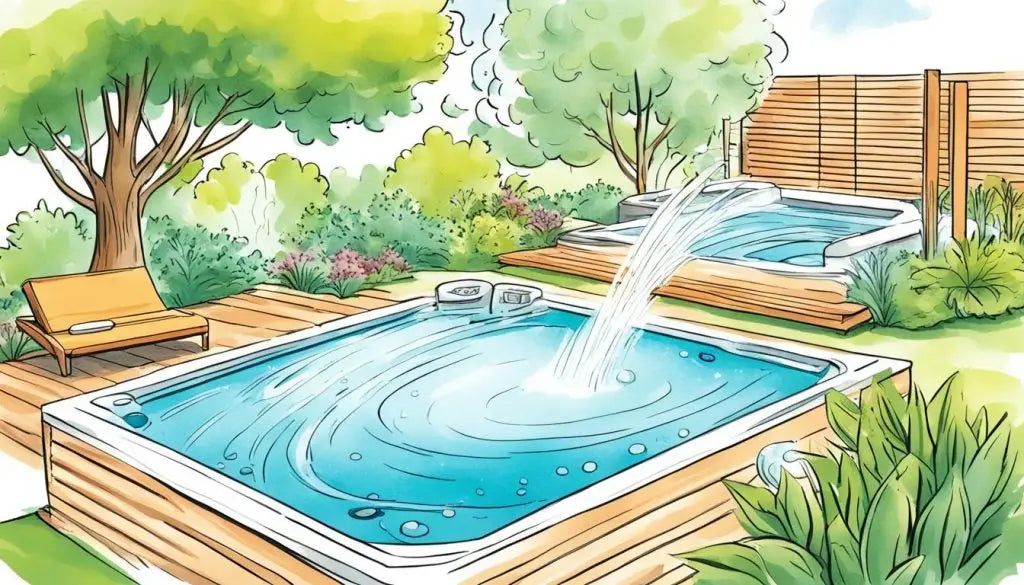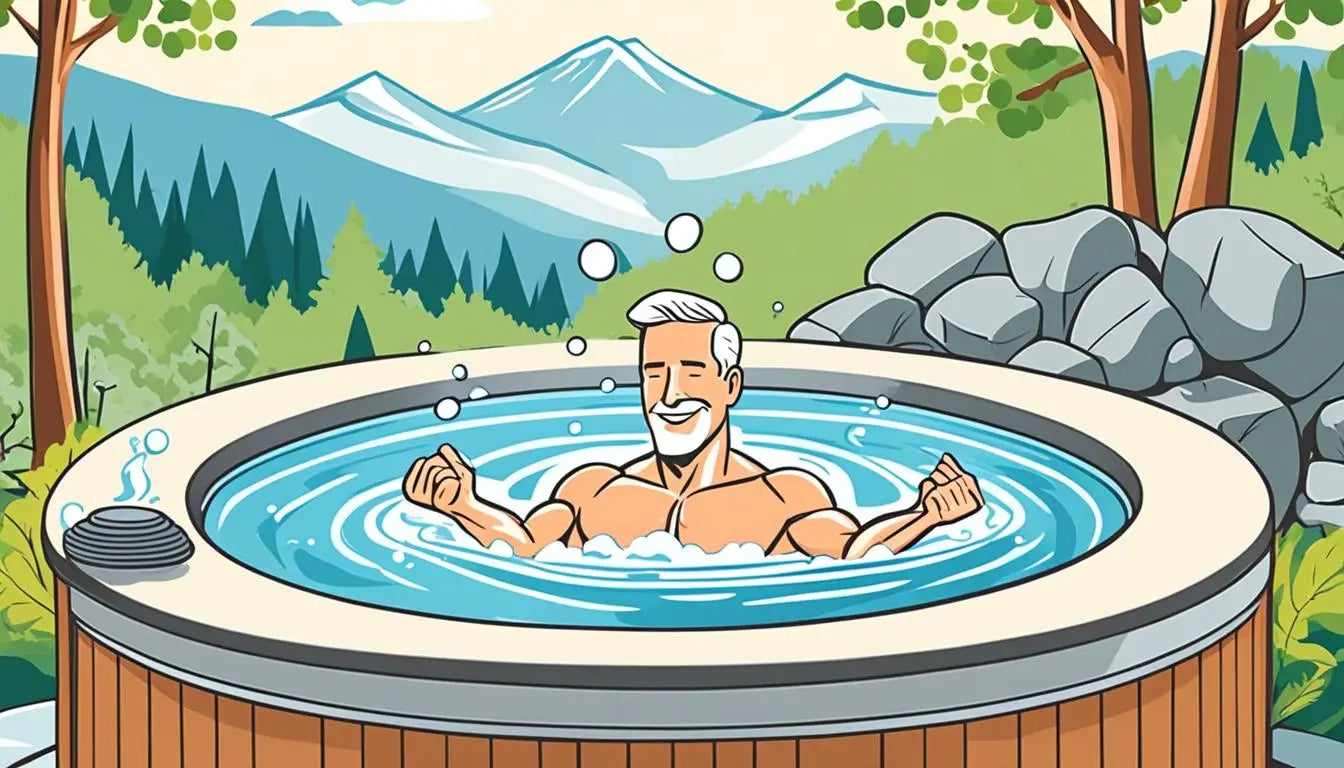Exercise is crucial for staying healthy. But, taking care of ourselves doesn't stop when we leave the gym. The real magic of feeling great happens when we take time to recover. Among many options, hot tubs stand out as a top choice for helping the body bounce back after working out. Soaking in a hot tub is more than just a treat. It is full of healing benefits. It eases muscles and makes our spirit feel better.
"To keep the body in good health is a duty, otherwise we shall not be able to keep our mind strong and clear." – Buddha.
Hot tubs have the power to heal and refresh after exercise. Their warm waters create a perfect space to relax once you've pushed hard. Muscles loosen up and the mind eases, turning a simple soak into a powerful way to feel good again. It's a complete experience that helps both body and mind recover. This is how the peace and science of getting better join together in the gentle waters of a hot tub.
Key Takeaways
- Understanding the rejuvenating hot tub benefits that support post-exercise recovery.
- Gathering insights on the relaxing properties of hot tubs and their role in muscle recuperation.
- Recognising the significance of heat therapy in the post-workout healing process.
- Exploring the harmony between physical relaxation and mental well-being afforded by hot tub use.
- Appreciating the indispensable contributions of a hot tub to a well-rounded wellbeing routine.
Why Delve into a Post Exercise Recovery Hot Tub?
Working out is great, but it's the recovery afterwards that really shapes your fitness and sports performance. Taking a dip in a hot tub isn't just a treat; it's a science-backed way to relax muscles and recover after tough workouts. Let's dive into how it works and why it's beneficial.
The Science of Heat Therapy and Muscle Relaxation
Heat therapy plays a big role in muscle relaxation, thanks to the recovery hot tub's warmth. Applying heat to tired muscles makes them relax and eases pain. Warmer temperatures make blood vessels wider, relaxing muscle tissue and loosening tension knots that cause stiffness.
Post-Workout Blood Flow Enhancement
Soaking in a hot tub after intense exercise helps increase blood flow. The warm water boosts circulation, bringing oxygen-rich blood to weary muscles. This not only removes waste faster but also helps with muscle repair and rebuilding during recovery.
Mitigating Inflammation for Swift Recuperation
Inflammation is a natural response to exercise-caused muscle damage. Hot tub heat therapy speeds up recovery by lowering inflammation and swelling. This allows athletes to get back to training sooner, reducing the chance of injuries from stiff muscles.
A hot tub soak is more than just relaxing. It's a proven recovery method. It helps with muscle relaxation, blood flow, and inflammation reduction. This makes a post-exercise hot tub soak an essential part of a recovery plan, not just a luxury.
Comparative Recovery Methods: Hot Tub Versus Ice Bath
Exploring sports recovery introduces many techniques to help the body recover. We see comparative recovery methods comparing the warmth of a hot tub to the cold of an ice bath. Both have their own benefits for recovery.
Evidence-Based Findings on Recovery Efficacy
Studies often compare different recovery methods. Hot tubs provide heat therapy to relax muscles. Ice baths, on the other hand, help reduce inflammation and get you ready for action quickly.
This ongoing research aims to find out which method is best for recovery. Athletes and fitness enthusiasts are keen to know the results.
User Preferences and Comfort Considerations
User preferences and comfort are crucial in choosing a recovery method. Some prefer the relaxing warmth of a hot tub. Others enjoy the refreshing feel of an ice bath, known for its rejuvenating effects.
The table below shows how these methods differ in key aspects:
| Recovery Method | Temperature Range | Typical Duration | Primary Benefit | User Comfort Level |
|---|---|---|---|---|
| Hot Tub | 37°C - 40°C | 15 - 30 minutes | Muscle relaxation | Highly comfortable (Preference for warmth) |
| Ice Bath | 10°C - 15°C | 10 - 15 minutes | Reduced inflammation and soreness | Varies (Preference for cold therapy) |
Your aims and the benefits you seek influence your choice. Fans of hot tubs enjoy their soothing warmth. Supporters of ice baths praise their quick and effective results.
The choice between a hot tub and an ice bath is not really personal and it depends on your what you want to achieve, your tolerance, time, and what you enjoy. As recovery methods evolve, these traditional options remain central to wellness and sports recovery debates.
Accelerate Healing with Improved Circulation
Hot tubs are not just for relaxation. They can also boost your improved circulation and help you heal. When you soak in a hot tub, your blood flow gets better. This is very important for fixing and looking after your body after working out.
The heat from a hot tub makes blood vessels bigger. This allows more oxygen and nutrients to reach tired muscles. It’s a key step in making a good space for healing. This can help you recover faster and feel less sore.
- Boosting Nutrient Delivery: Better circulation means nutrients and oxygen get to injured muscles faster, speeding up healing.
- Promoting Detoxification: It also leads to quicker removal of wastes like lactic acid from muscles.
- Reducing Recovery Time: With improved blood flow, recovery times are shorter, so you can get back to activities quicker.
Using a hot tub regularly for recovery can be very helpful. It is great for anyone who works out often, including athletes. Consider a hot tub a strong helper for quick healing and better improved circulation.
Hot tubs do more than ease daily stress. They are key for quick recovery and getting back into shape. They are perfect for anyone needing to bounce back to their best physical state fast.
Muscle Soreness and Pain Alleviation Techniques
Physical activity is crucial for healthy living. However, it can lead to muscle soreness. Techniques for pain alleviation have been developed, including hydrotherapy. Hydrotherapy is noted for its effectiveness in managing pain. This approach is backed by science and can improve recovery after exercise.
The Role of Hydrotherapy in Pain Management
Hydrotherapy plays a key role in managing muscle soreness. It uses water to ease sore muscles and boost well-being. A 2008 study showed hydrotherapy significantly reduces symptoms of soreness. Submerging in water helps lessen pain and stiffness in muscles.
Endorphin Release During Hot Tub Soaks
Hot tubs do more than relax us. They trigger an endorphin release, which fights pain. These hormones create a feeling of happiness. After exercise, hot tubs can lessen muscle soreness. They speed up the move from pain to calm with endorphins.

- Ice-water immersion: Sellwood et al. (2007) found it notably diminishes delayed-onset muscle soreness, providing pain alleviation post-exercise.
- Reduced Performance: Crowe et al. (2007) observed that ice-water immersion may potentially decrease anaerobic performance, suggesting a trade-off for immediate muscle soreness relief.
- Attenuation in Muscle Performance: Post-exercise muscle cooling, as reported by Yamane et al. (2006), can weaken the beneficial effects of endurance and resistance training on muscular performance.
| Author(s) | Year | Focus of Study | Key Findings |
|---|---|---|---|
| Sellwood et al. | 2007 | Impact of ice-water immersion on DOMS | Significant reduction in muscle soreness |
| Crowe et al. | 2007 | Effect of cold water immersion on anaerobic performance | Reduction in performance post-immersion |
| Yamane et al. | 2006 | Influence of muscle cooling post-exercise | Attenuation of training effects on muscle |
| McDonald et al. | 1984 | Body cooling in males via cold-water immersion | Documented body cooling post-exercise |
Hydrotherapy is proven for pain management and easing muscle soreness. But, it's important to weigh these benefits against possible impacts on performance. Balancing these can help tailor recovery to fit personal fitness aims and needs.
Amplifying Post-Workout Stress Relief
Working out regularly is key to staying healthy. But, what we do after exercise is just as important for keeping balanced. Hot tubs are popular for easing stress and offering a calming space for both mind and body. These benefits, enhanced by scientific research, go beyond simple relaxation following heavy physical activity.
Relaxing after exercising helps the body heal. Research in the Journal of Applied Physiology shows heat treatment reduces muscle pain and inflammation. This leads to quicker recovery from workouts.
How we recover after exercising can really impact our stress levels later on. A hot tub soak after working out boosts the body's way of dealing with stress. It helps both the mind and muscles relax. This means we're more ready and clear-minded for the next workout.
Using heat therapy aids recovery by various means. One major benefit is improved blood flow. This helps remove substances that cause inflammation after intense exercise. A study in the Frontiers in Physiology journal suggests heat therapy fits well into post-exercise recovery plans.
Besides fixing muscles, chilling in a hot tub after exercise also aims to achieve balance. Heating up the body can trigger reactions that help calm the body's stress handling systems. This shows how a warm soak can do more than just relax muscles; it helps our entire body reset.
In sum, real stress relief after working out comes from mixing active recovery and restful methods like hot tub soaks. Research backs up using heat as a powerful support alongside regular recovery techniques. It's shown to be not just a treat, but a science-backed way to help both body and mind bounce back better.
Mental and Emotional Boosts Post-Exercise
Relaxing in a hot tub after tough activities gives more than physical rest. It also offers a big mental boost. Soaking in warm water is a strong way to fight daily stress. It makes you feel calm quickly and this feeling lasts for many hours. The emotional boost feels like hitting a reset button. This is very helpful after the hard work of post-exercise.
Taking a warm bath can really improve your mood. The warmth helps melt away anxiety, making you forget worries for a while. As you relax in a hot tub, stress from the day fades. Your mind gets the chance to refresh.
“...there's nothing quite like the soothing sensation of warm water to ease the mind and uplift the spirits after a demanding workout.”
Water therapy and better emotional health are closely linked. This is because of how our bodies react to warmth and improved blood flow. The experience of soaking after exercise is not just about muscles. It greatly helps our mental state, too.
Here's a quick list of how a hot tub soak helps your mind and body after exercise:
| Benefit | Description |
|---|---|
| Mood Enhancement | Soaking in warm water boosts endorphin release. This raises your mood and makes you feel happier. |
| Stress Reduction | Heat and water make you feel less physical stress. This helps calm your mind too. |
| Anxiety Alleviation | Hot tub soaking reduces cortisol levels. This decreases feelings of anxiety. |
| Cognitive Clarity | Relaxing in a hot tub after exercise helps clear your mind. It improves focus and brain function. |
It's important to see exercise recovery in a full way. Hot tub benefits go beyond just physical ones. By improving mental and emotional health, soaking after exercise is key. It helps not just the body recover, but also strengthens the mind.
Advantages of Flexibility Gains from Hot Tub Use
Regular hot tub use offers key advantages, including significant flexibility gains. The heat from a hot tub helps beat stress. It also improves your range of motion. Flexibility is crucial for athletes to perform well and avoid injuries.
Heat therapy explains why hot tubs aid in flexibility. Soaking in warm water makes your body warm inside. This causes your blood vessels to widen, which helps your blood circulate better. This means your muscles get the nutrients they need quicker. Plus, water's buoyancy cuts down gravity's pull, making stretching easier and easing joint stress.
“Incorporating hot tub use into one’s post-workout routine can significantly expedite the flexibility enhancement process, leading to both immediate and long-term benefits for the user.”
- Expansion of Range of Motion
- Acceleration of Muscle Recovery
- Reduction in Post-Workout Downtime
| Benefit | Description | Impact on Performance |
|---|---|---|
| Improved Joint Elasticity | Heat from a hot tub can make connective tissues more pliable, thus enhancing joint elasticity. | Facilitates greater mobility and reduces the risk of strains or sprains during physical activity. |
| Relief from Muscle Tension | The hot water's soothing effect helps to relax muscle fibres, relieving tension and aiding in flexibility. | Enables athletes to perform a wider range of movement patterns with reduced discomfort. |
| Decreased Muscle Soreness | Hydrotherapy promotes faster removal of lactic acid, thus decreasing muscle soreness. | Allows for more frequent training sessions with less pain and stiffness afterwards. |
But flexibility gains from hot tub use aren't just for athletes. In our busy lives, these benefits help us move better every day. Doing simple tasks becomes easier and less painful. It's vital to understand these perks among the many wellness practices we have today.
Post Exercise Recovery Hot Tub Timing
It's key to get the timing right when using hot baths for post-exercise recovery. Finding the right moment to relax and taking care is vital. This helps get the most out of hot baths while keeping risks low.
The Optimal Moment for Hot Tub Soaking
After a tough workout, your body needs to start recovering before you introduce heat. The best time to get into a hot tub is within 45 to 60 minutes after working out. This lets your heart rate settle and your body cool down. Then, you are ready to enjoy the hot tub's benefits.
Precautions in Hot Bathing Practices
Taking care with hot baths is part of a good recovery plan. Staying hydrated is important due to the heat making you lose moisture. Also, keep your hot bath under 20 minutes to avoid getting too hot or dizzy. This makes sure your hot bath is refreshing and safe.
| Timing | Duration | Temperature | Precautionary Note |
|---|---|---|---|
| 45-60 minutes post-exercise | Maximum of 20 minutes | 37-39°C (98.6-102.2°F) | Stay hydrated; avoid alcohol |
| Post cool-down | Start with shorter sessions | Adjust to comfort | Monitor heart rate |
| Before muscle stiffness sets in | Increase gradually with tolerance | Avoid exceeding 40°C (104°F) | Be cautious of slip hazards |

Being mindful of these tips can make your recovery better. It also makes the post-workout time more pleasant and effective.
Navigating Potential Risks and How to Mitigate Them
Enjoying a hot tub after exercise can be refreshing, but it comes with risks. It's important to know these risks to stay safe and well. Using a hot tub too often for post-exercise recovery could make you too hot or dehydrated. Being in high heat for too long may lead to sickness, especially if you don't drink enough water. To avoid problems, keep your soaking time short and always drink plenty of water.
To keep safe and get the most from your hot tub, regular cleaning and care are key. Make sure the hot tub is clean and the water's chemistry is right. This stops harmful bacteria from growing, which can cause skin problems or other health issues. Also, always stay clean before and after using the hot tub. If you're healing from an injury, check with a doctor before using the hot tub.
Adding hot tubs to your recovery routine can be good, but be aware of the risks. By following simple safety steps, like taking care of the hot tub, staying hydrated, and managing your time, you can enjoy its benefits. Using hot tubs wisely is vital for mixing health and enjoyment after working out.
FAQ
What are the benefits of using a hot tub for post-exercise recovery?
After exercising, hot tubs are great for your muscles. They help relax muscles with their warmth. They also boost blood flow, reduce swelling, and speed up recovery. Hot tubs ease muscle pain, improve mood, and help you feel less stressed.
How does heat therapy in hot tubs promote muscle relaxation?
Heat therapy in hot tubs warms up your muscles. This warmth makes blood vessels expand, boosting circulation. It helps relax muscles and ease tension, making you feel better after working out.
Does using a hot tub enhance blood flow after a workout?
Yes, soaking in a hot tub after working out does help. The warmth makes your blood vessels get bigger, which means better blood circulation. This helps get nutrients and oxygen to your muscles faster, aiding in recovery.
How do hot tubs reduce inflammation in muscles and joints?
Hot tubs use heat therapy to help with inflamed muscles and joints. The heat makes blood vessels expand, increasing circulation. This helps clear out waste and reduces swelling, offering relief.
How do hot tubs compare to ice baths as recovery methods?
Hot tubs and ice baths both aid in recovery, but they work differently. Hot tubs relax muscles and boost circulation. Ice baths reduce swelling and numb pain. Which one you choose depends on your recovery needs and what feels best for you.
Are there evidence-based findings on the efficacy of hot tubs and ice baths for recovery?
Indeed, research supports the use of both hot tubs and ice baths for recovery. Studies show they can lessen muscle pain and improve movement. However, how you react can vary. It's important to choose what feels right for you.
How do hot tubs improve circulation and accelerate the healing process?
Hot tubs help by expanding blood vessels and boosting blood flow. This means your muscles get more nutrients and oxygen, aiding their healing after you exercise.
How can hot tubs alleviate muscle soreness and pain?
By soaking in a hot tub, you can ease muscle pain and soreness. The warm water lessens muscle and joint pressure. Plus, hot tubs help your body release endorphins, which are natural painkillers.
What role does hydrotherapy play in pain management for post-exercise recovery?
Hydrotherapy uses water to help with post-exercise pain. In a hot tub, the warm water and pressure relieve joint and muscle pain. It's a great way to relax and help your body recover.
How do hot tub soaks stimulate the release of endorphins?
Soaking in a hot tub can make your body release endorphins. These are chemicals that help reduce pain and make you feel good. The combination of warm water and the hot tub's soothing effects trigger this release.
How do hot tubs amplify post-workout stress relief?
Hot tubs offer a peaceful escape, which can help lower stress after workouts. The warm water and gentle jets add to this calming effect, helping you unwind and feel more relaxed.
What are the mental and emotional benefits of using a hot tub after exercise?
Using a hot tub post-workout can lift your mood and decrease anxiety. The warmth and relaxation it offers help refresh your mind and improve your overall sense of well-being.
How do hot tubs contribute to improving flexibility?
The warmth from hot tubs helps relax and make your muscles more flexible. Being more flexible can improve your performance, lower injury risk, and promote physical health.
When is the optimal time to use a hot tub for post-exercise recovery?
The best time to use a hot tub for recovery is within 30 minutes to 2 hours after exercise. This timing maximises the benefits of heat therapy and muscle relaxation.
What precautions should I consider when using a hot tub for post-exercise recovery?
Be careful when using a hot tub for recovery. Keep the water at a safe temperature and don't stay in too long. Drink plenty of water and check with a doctor if you have health issues.
Are there potential risks associated with hot tub use for post-exercise recovery?
Yes, there are risks like overheating and getting dehydrated. Keeping your hot tub clean can also prevent illness. But, you can manage these risks with proper usage and upkeep.








































